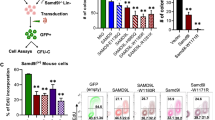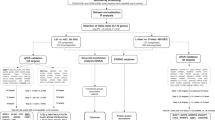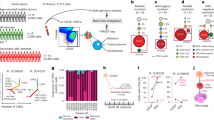Abstract
To gain insight into the molecular pathogenesis of the myelodysplastic syndromes (MDS), we performed global gene expression profiling and pathway analysis on the hematopoietic stem cells (HSC) of 183 MDS patients as compared with the HSC of 17 healthy controls. The most significantly deregulated pathways in MDS include interferon signaling, thrombopoietin signaling and the Wnt pathways. Among the most significantly deregulated gene pathways in early MDS are immunodeficiency, apoptosis and chemokine signaling, whereas advanced MDS is characterized by deregulation of DNA damage response and checkpoint pathways. We have identified distinct gene expression profiles and deregulated gene pathways in patients with del(5q), trisomy 8 or −7/del(7q). Patients with trisomy 8 are characterized by deregulation of pathways involved in the immune response, patients with −7/del(7q) by pathways involved in cell survival, whereas patients with del(5q) show deregulation of integrin signaling and cell cycle regulation pathways. This is the first study to determine deregulated gene pathways and ontology groups in the HSC of a large group of MDS patients. The deregulated pathways identified are likely to be critical to the MDS HSC phenotype and give new insights into the molecular pathogenesis of this disorder, thereby providing new targets for therapeutic intervention.
This is a preview of subscription content, access via your institution
Access options
Subscribe to this journal
Receive 12 print issues and online access
$259.00 per year
only $21.58 per issue
Buy this article
- Purchase on Springer Link
- Instant access to full article PDF
Prices may be subject to local taxes which are calculated during checkout


Similar content being viewed by others
References
Heaney ML, Golde DW . Myelodysplasia. N Engl J Med 1999; 340: 1649–1660.
Greenberg PL, Young NS, Gattermann N . Myelodysplastic syndromes. Hematology Am Soc Hematol Educ Program 2002, 136–161.
Komrokji RS, Bennett JM . Evolving classifications of the myelodysplastic syndromes. Curr Opin Hematol 2007; 14: 98–105.
Steensma DP, Tefferi A . The myelodysplastic syndrome(s): a perspective and review highlighting current controversies. Leuk Res 2003; 27: 95–120.
Bennett JM, Catovsky D, Daniel MT, Flandrin G, Galton DA, Gralnick HR et al. Proposals for the classification of the myelodysplastic syndromes. Br J Haematol 1982; 51: 189–199.
Swerdlow SH, Campo E, Harris NL, Jaffe ES, Pileri SA, Stein H et al, eds. WHO Classification of Tumours of Haematopoietic and Lymphoid Tissues. IARC: Lyon, 2008.
Harris NL, Jaffe ES, Diebold J, Flandrin G, Muller-Hermelink HK, Vardiman J et al. The World Health Organization classification of neoplastic diseases of the hematopoietic and lymphoid tissues. Report of the Clinical Advisory Committee meeting, Airlie House, Virginia, November, 1997. Ann Oncol 1999; 10: 1419–1432.
Greenberg P, Cox C, LeBeau MM, Fenaux P, Morel P, Sanz G et al. International scoring system for evaluating prognosis in myelodysplastic syndromes. Blood 1997; 89: 2079–2088.
Sanz GF, Sanz MA, Greenberg PL . Prognostic factors and scoring systems in myelodysplastic syndromes. Haematologica 1998; 83: 358–368.
Olney HJ, Le Beau MM . The cytogenetics of myelodysplastic syndromes. Best Pract Res Clin Haematol 2001; 14: 479–495.
Van den Berghe H, Cassiman JJ, David G, Fryns JP, Michaux JL, Sokal G . Distinct haematological disorder with deletion of long arm of no. 5 chromosome. Nature 1974; 251: 437–438.
Boultwood J, Lewis S, Wainscoat JS . The 5q-syndrome. Blood 1994; 84: 3253–3260.
Giagounidis AA, Germing U, Wainscoat JS, Boultwood J, Aul C . The 5q- syndrome. Hematology 2004; 9: 271–277.
Maciejewski JP, Risitano A, Sloand EM, Nunez O, Young NS . Distinct clinical outcomes for cytogenetic abnormalities evolving from aplastic anemia. Blood 2002; 99: 3129–3135.
Steensma DP, List AF . Genetic testing in the myelodysplastic syndromes: molecular insights into hematologic diversity. Mayo Clin Proc 2005; 80: 681–698.
Langemeijer SM, Kuiper RP, Berends M, Knops R, Aslanyan MG, Massop M et al. Acquired mutations in TET2 are common in myelodysplastic syndromes. Nat Genet 2009; 41: 838–842.
List A, Dewald G, Bennett J, Giagounidis A, Raza A, Feldman E et al. Lenalidomide in the myelodysplastic syndrome with chromosome 5q deletion. N Engl J Med 2006; 355: 1456–1465.
Fenaux P, Mufti GJ, Hellstrom-Lindberg E, Santini V, Finelli C, Giagounidis A et al. Efficacy of azacitidine compared with that of conventional care regimens in the treatment of higher-risk myelodysplastic syndromes: a randomised, open-label, phase III study. Lancet Oncol 2009; 10: 223–232.
Jadersten M, Hellstrom-Lindberg E . Myelodysplastic syndromes: biology and treatment. J Intern Med 2009; 265: 307–328.
Boehrer S, Ades L, Tajeddine N, Hofmann WK, Kriener S, Bug G et al. Suppression of the DNA damage response in acute myeloid leukemia versus myelodysplastic syndrome. Oncogene 2009; 28: 2205–2218.
Network CGAR. Comprehensive genomic characterization defines human glioblastoma genes and core pathways. Nature 2008; 455: 1061–1068.
Jones S, Zhang X, Parsons DW, Lin JC, Leary RJ, Angenendt P et al. Core signaling pathways in human pancreatic cancers revealed by global genomic analyses. Science 2008; 321: 1801–1806.
Irizarry RA, Hobbs B, Collin F, Beazer-Barclay YD, Antonellis KJ, Scherf U et al. Exploration, normalization, and summaries of high density oligonucleotide array probe level data. Biostatistics 2003; 4: 249–264.
Edgar R, Domrachev M, Lash AE . Gene Expression Omnibus: NCBI gene expression and hybridization array data repository. Nucleic Acids Res 2002; 30: 207–210.
Kitagawa M, Saito I, Kuwata T, Yoshida S, Yamaguchi S, Takahashi M et al. Overexpression of tumor necrosis factor (TNF)-alpha and interferon (IFN)-gamma by bone marrow cells from patients with myelodysplastic syndromes. Leukemia 1997; 11: 2049–2054.
Felli N, Pedini F, Zeuner A, Petrucci E, Testa U, Conticello C et al. Multiple members of the TNF superfamily contribute to IFN-gamma-mediated inhibition of erythropoiesis. J Immunol 2005; 175: 1464–1472.
Yang L, Dybedal I, Bryder D, Nilsson L, Sitnicka E, Sasaki Y et al. IFN-gamma negatively modulates self-renewal of repopulating human hemopoietic stem cells. J Immunol 2005; 174: 752–757.
Pellagatti A, Cazzola M, Giagounidis AA, Malcovati L, Porta MG, Killick S et al. Gene expression profiles of CD34+ cells in myelodysplastic syndromes: involvement of interferon-stimulated genes and correlation to FAB subtype and karyotype. Blood 2006; 108: 337–345.
Hofmann WK, Kalina U, Wagner S, Seipelt G, Ries C, Hoelzer D et al. Characterization of defective megakaryocytic development in patients with myelodysplastic syndromes. Exp Hematol 1999; 27: 395–400.
Kaushansky K, Broudy VC, Lin N, Jorgensen MJ, McCarty J, Fox N et al. Thrombopoietin, the Mp1 ligand, is essential for full megakaryocyte development. Proc Natl Acad Sci USA 1995; 92: 3234–3238.
Yamazaki S, Nakauchi H . Insights into signaling and function of hematopoietic stem cells at the single-cell level. Curr Opin Hematol 2009; 16: 255–258.
Majeti R, Becker MW, Tian Q, Lee TL, Yan X, Liu R et al. Dysregulated gene expression networks in human acute myelogenous leukemia stem cells. Proc Natl Acad Sci USA 2009; 106: 3396–3401.
Jamieson CH, Ailles LE, Dylla SJ, Muijtjens M, Jones C, Zehnder JL et al. Granulocyte-macrophage progenitors as candidate leukemic stem cells in blast-crisis CML. N Engl J Med 2004; 351: 657–667.
Bellini O, Casazza AM, di Marco A . Histological and histochemical studies of myocardial lesions in BALBc/Cr mice. Lab Anim Sci 1976; 26: 329–333.
Kotsianidis I, Bouchliou I, Nakou E, Spanoudakis E, Margaritis D, Christophoridou AV et al. Kinetics, function and bone marrow trafficking of CD4+CD25+FOXP3+ regulatory T cells in myelodysplastic syndromes (MDS). Leukemia 2009; 23: 510–518.
Sloand EM, Rezvani K . The role of the immune system in myelodysplasia: implications for therapy. Semin Hematol 2008; 45: 39–48.
Sternberg A, Killick S, Littlewood T, Hatton C, Peniket A, Seidl T et al. Evidence for reduced B-cell progenitors in early (low-risk) myelodysplastic syndrome. Blood 2005; 106: 2982–2991.
Rajapaksa R, Ginzton N, Rott LS, Greenberg PL . Altered oncoprotein expression and apoptosis in myelodysplastic syndrome marrow cells. Blood 1996; 88: 4275–4287.
Parker JE, Mufti GJ, Rasool F, Mijovic A, Devereux S, Pagliuca A . The role of apoptosis, proliferation, and the Bcl-2-related proteins in the myelodysplastic syndromes and acute myeloid leukemia secondary to MDS. Blood 2000; 96: 3932–3938.
Tehranchi R, Invernizzi R, Grandien A, Zhivotovsky B, Fadeel B, Forsblom AM et al. Aberrant mitochondrial iron distribution and maturation arrest characterize early erythroid precursors in low-risk myelodysplastic syndromes. Blood 2005; 106: 247–253.
Bartkova J, Horejsi Z, Koed K, Kramer A, Tort F, Zieger K et al. DNA damage response as a candidate anti-cancer barrier in early human tumorigenesis. Nature 2005; 434: 864–870.
Ko MA, Rosario CO, Hudson JW, Kulkarni S, Pollett A, Dennis JW et al. Plk4 haploinsufficiency causes mitotic infidelity and carcinogenesis. Nat Genet 2005; 37: 883–888.
Lam MH, Liu Q, Elledge SJ, Rosen JM . Chk1 is haploinsufficient for multiple functions critical to tumor suppression. Cancer Cell 2004; 6: 45–59.
Zhao H, Watkins JL, Piwnica-Worms H . Disruption of the checkpoint kinase 1/cell division cycle 25A pathway abrogates ionizing radiation-induced S and G2 checkpoints. Proc Natl Acad Sci USA 2002; 99: 14795–14800.
West SC . Molecular views of recombination proteins and their control. Nat Rev Mol Cell Biol 2003; 4: 435–445.
Bindra RS, Glazer PM . Repression of RAD51 gene expression by E2F4/p130 complexes in hypoxia. Oncogene 2007; 26: 2048–2057.
Garuti G, Genazzani AR . Human neu oncogene is expressed in endometrial but not in ovarian adenocarcinomas. Cancer 1991; 67: 1713.
Tischkowitz M, Dokal I . Fanconi anaemia and leukaemia—clinical and molecular aspects. Br J Haematol 2004; 126: 176–191.
Potapova O, Basu S, Mercola D, Holbrook NJ . Protective role for c-Jun in the cellular response to DNA damage. J Biol Chem 2001; 276: 28546–28553.
Kinjo K, Sandoval S, Sakamoto KM, Shankar DB . The role of CREB as a proto-oncogene in hematopoiesis. Cell Cycle 2005; 4: 1134–1135.
Hanahan D, Weinberg RA . The hallmarks of cancer. Cell 2000; 100: 57–70.
Montecucco C, Riccardi A, Traversi E, Giordano P, Mazzini G, Ascari E . Proliferative activity of bone marrow cells in primary dysmyelopoietic (preleukemic) syndromes. Cancer 1983; 52: 1190–1195.
Varma N, Varma S . Proliferative indices, cytogenetics, immunophenotye and other prognostic parameters in myelodysplastic syndromes. Indian J Pathol Microbiol 2008; 51: 97–101.
Alexandrakis MG, Passam FH, Kyriakou DS, Dambaki C, Katrinakis G, Tsirakis G et al. Expression of the proliferation-associated nuclear protein MIB-1 and its relationship with microvascular density in bone marrow biopsies of patients with myelodysplastic syndromes. J Mol Histol 2004; 35: 857–863.
Fenaux P . Chromosome and molecular abnormalities in myelodysplastic syndromes. Int J Hematol 2001; 73: 429–437.
Mufti GJ . Pathobiology, classification, and diagnosis of myelodysplastic syndrome. Best Pract Res Clin Haematol 2004; 17: 543–557.
Haase D, Germing U, Schanz J, Pfeilstocker M, Nosslinger T, Hildebrandt B et al. New insights into the prognostic impact of the karyotype in MDS and correlation with subtypes: evidence from a core dataset of 2124 patients. Blood 2007; 110: 4385–4395.
Chen G, Zeng W, Miyazato A, Billings E, Maciejewski JP, Kajigaya S et al. Distinctive gene expression profiles of CD34 cells from patients with myelodysplastic syndrome characterized by specific chromosomal abnormalities. Blood 2004; 104: 4210–4218.
Sloand EM, Kim S, Fuhrer M, Risitano AM, Nakamura R, Maciejewski JP et al. Fas-mediated apoptosis is important in regulating cell replication and death in trisomy 8 hematopoietic cells but not in cells with other cytogenetic abnormalities. Blood 2002; 100: 4427–4432.
Bouscary D, De Vos J, Guesnu M, Jondeau K, Viguier F, Melle J et al. Fas/Apo-1 (CD95) expression and apoptosis in patients with myelodysplastic syndromes. Leukemia 1997; 11: 839–845.
Boultwood J, Pellagatti A, Cattan H, Lawrie CH, Giagounidis A, Malcovati L et al. Gene expression profiling of CD34+ cells in patients with the 5q- syndrome. Br J Haematol 2007; 139: 578–589.
Pellagatti A, Hellstrom-Lindberg E, Giagounidis A, Perry J, Malcovati L, Della Porta MG et al. Haploinsufficiency of RPS14 in 5q- syndrome is associated with deregulation of ribosomal- and translation-related genes. Br J Haematol 2008; 142: 57–64.
Weston CR, Davis RJ . The JNK signal transduction pathway. Curr Opin Cell Biol 2007; 19: 142–149.
Carpinteiro A, Dumitru C, Schenck M, Gulbins E . Ceramide-induced cell death in malignant cells. Cancer Lett 2008; 264: 1–10.
Hutchinson J, Jin J, Cardiff RD, Woodgett JR, Muller WJ . Activation of Akt (protein kinase B) in mammary epithelium provides a critical cell survival signal required for tumor progression. Mol Cell Biol 2001; 21: 2203–2212.
Tanaka T, De Luca LM . Therapeutic potential of ‘rexinoids’ in cancer prevention and treatment. Cancer Res 2009; 69: 4945–4947.
Dominguez I, Sonenshein GE, Seldin DC . Protein kinase CK2 in health and disease: CK2 and its role in Wnt and NF-kappaB signaling: linking development and cancer. Cell Mol Life Sci 2009; 66: 1850–1857.
Graham SM, Cox AD, Drivas G, Rush MG, D’Eustachio P, Der CJ . Aberrant function of the Ras-related protein TC21/R-Ras2 triggers malignant transformation. Mol Cell Biol 1994; 14: 4108–4115.
Clark GJ, Kinch MS, Gilmer TM, Burridge K, Der CJ . Overexpression of the Ras-related TC21/R-Ras2 protein may contribute to the development of human breast cancers. Oncogene 1996; 12: 169–176.
Acknowledgements
This work was supported by Leukaemia Research of the United Kingdom, and in part by grants from AIRC (Associazione Italiana per la Ricerca sul Cancro) and Fondazione IRCCS Policlinico San Matteo to MC.
Author information
Authors and Affiliations
Corresponding author
Ethics declarations
Competing interests
The authors declare no conflict of interest.
Additional information
Supplementary Information accompanies the paper on the Leukemia website
Rights and permissions
About this article
Cite this article
Pellagatti, A., Cazzola, M., Giagounidis, A. et al. Deregulated gene expression pathways in myelodysplastic syndrome hematopoietic stem cells. Leukemia 24, 756–764 (2010). https://doi.org/10.1038/leu.2010.31
Received:
Revised:
Accepted:
Published:
Issue Date:
DOI: https://doi.org/10.1038/leu.2010.31
Keywords
This article is cited by
-
A miRNA screening identifies miR-192-5p as associated with response to azacitidine and lenalidomide therapy in myelodysplastic syndromes
Clinical Epigenetics (2023)
-
Role of innate immunological/inflammatory pathways in myelodysplastic syndromes and AML: a narrative review
Experimental Hematology & Oncology (2023)
-
Targeting PD-1/PD-L1 pathway in myelodysplastic syndromes and acute myeloid leukemia
Experimental Hematology & Oncology (2022)
-
Identification of RIOK2 as a master regulator of human blood cell development
Nature Immunology (2022)
-
RUNX1 mutations contribute to the progression of MDS due to disruption of antitumor cellular defense: a study on patients with lower-risk MDS
Leukemia (2022)



